In this project, I have to make a small change to the Linux source code.
I am using a C++ compiler.
Please refer to the parts in the images attached below to help me figure out this assignment:
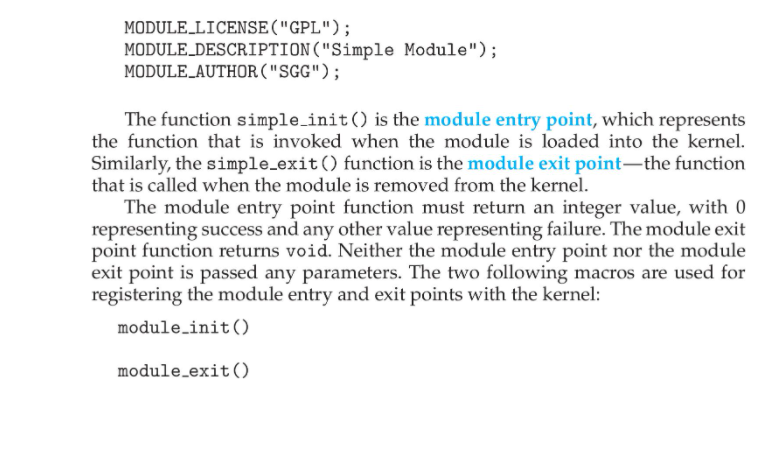
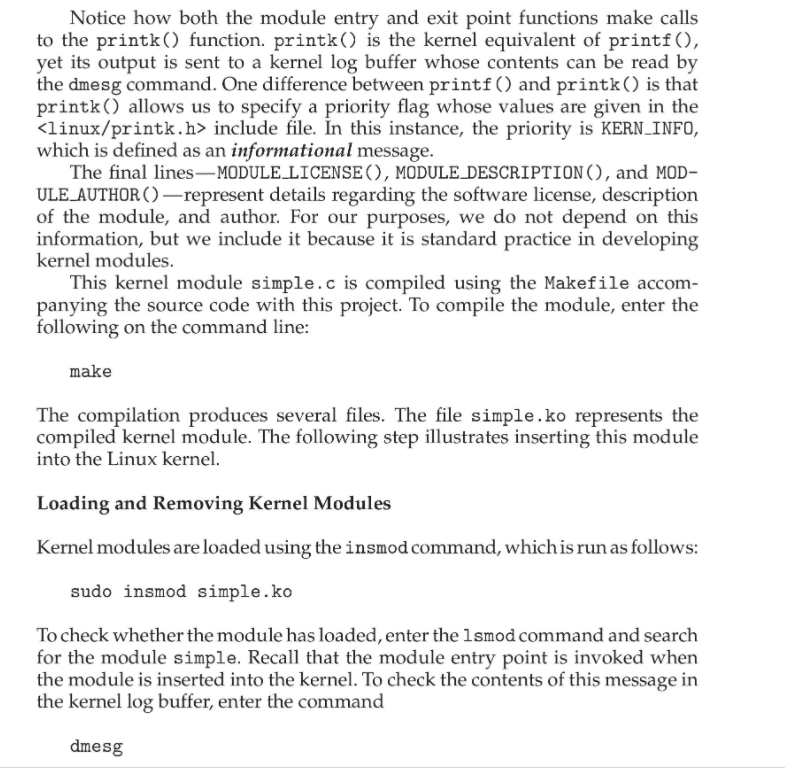
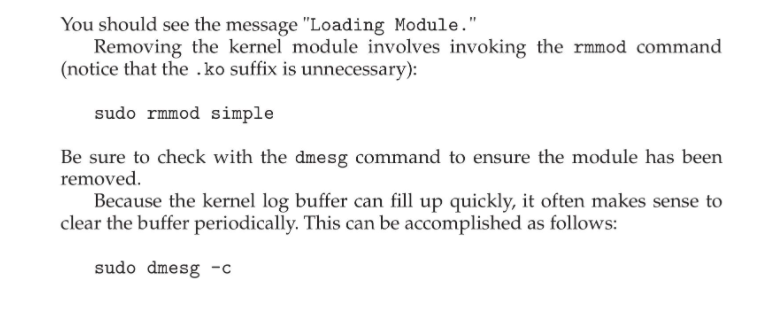



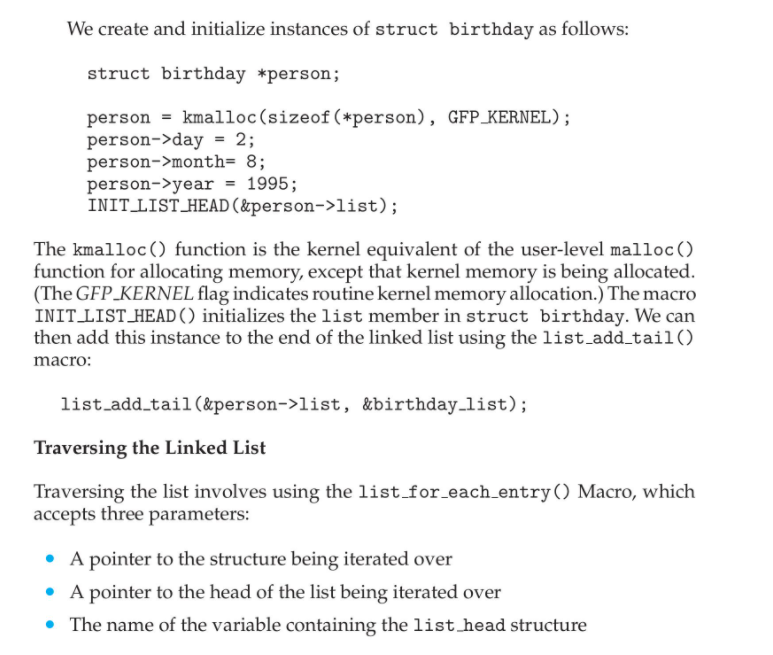
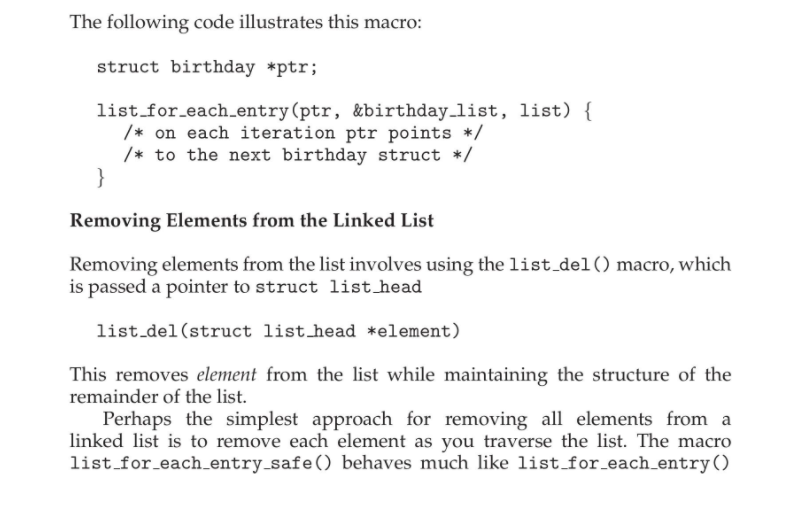
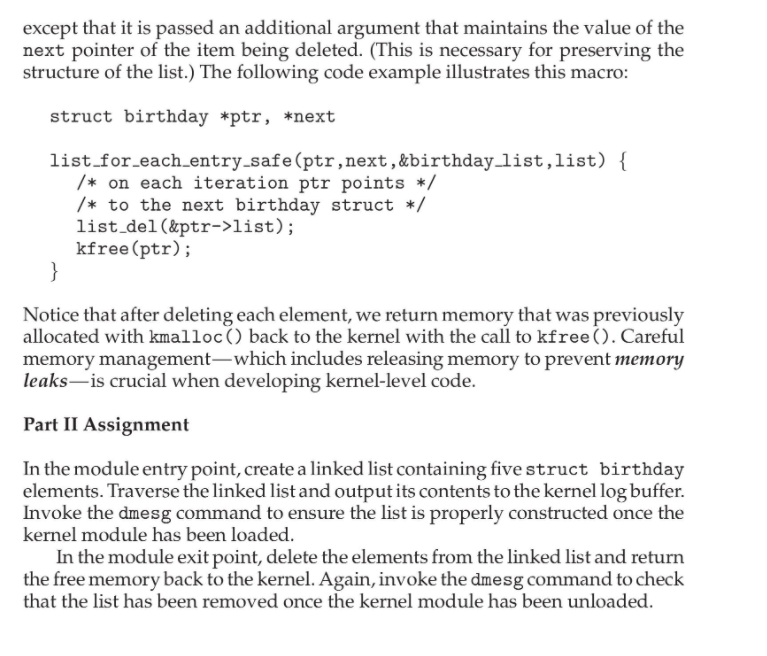
I have to take screenshots of the code that is added to the Linux source.
Also, I need to take screenshots of the kernel log buffer to show successful addition, traversal, and deletion of the specified elements.
I used Nitrix Ubuntu Linux on my VM Server and found it was compatible with a C++ compiler. I searched in the 'command prompt' for "gcc" which is a software that allows for C++ compiling. I found it was not installed so I installed that on my server as well as "make" in order to prepare for C++ language coding on my Linux OS.
You can list all kernel modules that are currently loaded by entering the command lsmod This command will list the current kernel modules in three columns: name, size, and where the module is being used. The following program (named simple.c and available with the source code for this text) illustrates a very basic kernel module that prints appropriate messages when the kernel module is loaded and unloaded. #include
#include #include /* This function is called when the module is loaded. */ int simple_init(void) { printk(KERN_INFO "Loading Module n"); return 0; } /* This function is called when the module is removed. */ void simple_exit(void) { printk(KERN_INFO "Removing Module "); } /* Macros for registering module entry and exit points. */ module_init(simple_init); module_exit(simple_exit); MODULE_LICENSE("GPL"); MODULE_DESCRIPTION("Simple Module"); MODULE_AUTHOR("SGG"); The function simple_init() is the module entry point, which represents the function that is invoked when the module is loaded into the kernel. Similarly, the simple_exit() function is the module exit pointthe function that is called when the module is removed from the kernel. The module entry point function must return an integer value, with 0 representing success and any other value representing failure. The module exit point function returns void. Neither the module entry point nor the module exit point is passed any parameters. The two following macros are used for registering the module entry and exit points with the kernel: module_init() module_exit() Notice how both the module entry and exit point functions make calls to the printk() function. printk() is the kernel equivalent of printf(), yet its output is sent to a kernel log buffer whose contents can be read by the dmesg command. One difference between printf() and printk() is that printk() allows us to specify a priority flag whose values are given in the include file. In this instance, the priority is KERN_INFO, which is defined as an informational message. The final linesMODULE LICENSE(), MODULE DESCRIPTION(), and MOD- ULE_AUTHOR()-represent details regarding the software license, description of the module, and author. For our purposes, we do not depend on this information, but we include it because it is standard practice in developing kernel modules. This kernel module simple.c is compiled using the Makefile accom- panying the source code with this project. To compile the module, enter the following on the command line: make The compilation produces several files. The file simple. ko represents the compiled kernel module. The following step illustrates inserting this module into the Linux kernel. Loading and Removing Kernel Modules Kernel modules are loaded using the insmod command, which is run as follows: sudo insmod simple.ko To check whether the module has loaded, enter the lsmod command and search for the module simple. Recall that the module entry point is invoked when the module is inserted into the kernel. To check the contents of this message in the kernel log buffer, enter the command dmesg You should see the message "Loading Module." Removing the kernel module involves invoking the rmmod command (notice that the .ko suffix is unnecessary): sudo rmmod simple Be sure to check with the dmesg command to ensure the module has been removed. Because the kernel log buffer can fill up quickly, it often makes sense to clear the buffer periodically. This can be accomplished as follows: sudo dmesg -C Part I Assignment Proceed through the steps described above to create the kernel module and to load and unload the module. Be sure to check the contents of the kernel log buffer using dmesg to ensure you have properly followed the steps. Part II-Kernel Data Structures The second part of this project involves modifying the kernel module so that it uses the kernel linked-list data structure. In Section 1.10, we covered various data structures that are common in operating systems. The Linux kernel provides several of these structures. Here, we explore using the circular, doubly linked list that is available to kernel developers. Much of what we discuss is available in the Linux source code- in this instance, the include file -and we recommend that you examine this file as you proceed through the following steps. Initially, you must define a struct containing the elements that are to be inserted in the linked list. The following C struct defines birthdays: struct birthday { int day; int month; int year; struct list head list; Notice the member struct list head list. The list_head structure is defined in the include file . Its intention is to embed the linked list within the nodes that comprise the list. This list head structure is quite simple-it merely holds two members, next and prev, that point to the next and previous entries in the list. By embedding the linked list within the structure, Linux makes it possible to manage the data structure with a series of macro functions. Part I Assignment Proceed through the steps described above to create the kernel module and to load and unload the module. Be sure to check the contents of the kernel log buffer using dmesg to ensure you have properly followed the steps. Part II-Kernel Data Structures The second part of this project involves modifying the kernel module so that it uses the kernel linked-list data structure. In Section 1.10, we covered various data structures that are common in operating systems. The Linux kernel provides several of these structures. Here, we explore using the circular, doubly linked list that is available to kernel developers. Much of what we discuss is available in the Linux source code- in this instance, the include file -and we recommend that you examine this file as you proceed through the following steps. Initially, you must define a struct containing the elements that are to be inserted in the linked list. The following C struct defines birthdays: struct birthday { int day; int month; int year; struct list head list; Notice the member struct list head list. The list_head structure is defined in the include file . Its intention is to embed the linked list within the nodes that comprise the list. This list head structure is quite simple-it merely holds two members, next and prev, that point to the next and previous entries in the list. By embedding the linked list within the structure, Linux makes it possible to manage the data structure with a series of macro functions. Inserting Elements into the Linked List We can declare a list_head object, which we use as a reference to the head of the list by using the LIST_HEAD() macro static LIST_HEAD(birthday_list); This macro defines and initializes the variable birthday-list, which is of type struct list head. We create and initialize instances of struct birthday as follows: struct birthday *person; person = kmalloc(sizeof(*person), GFP KERNEL); person->day = 2; person->month= 8; person->year = 1995; INIT_LIST_HEAD(&person->list); The kmalloc() function is the kernel equivalent of the user-level malloc() function for allocating memory, except that kernel memory is being allocated. (The GFP_KERNEL flag indicates routine kernel memory allocation.) The macro INIT_LIST_HEAD() initializes the list member in struct birthday. We can then add this instance to the end of the linked list using the list_add_tail() macro: list_add_tail(&person->list, &birthday-list); Traversing the Linked List Traversing the list involves using the list_for_each_entry() Macro, which accepts three parameters: A pointer to the structure being iterated over A pointer to the head of the list being iterated over The name of the variable containing the list head structure The following code illustrates this macro: struct birthday *ptr; list_for_each_entry(ptr, &birthday-list, list) { /* on each iteration ptr points */ /* to the next birthday struct */ } Removing Elements from the Linked List Removing elements from the list involves using the list_del() macro, which is passed a pointer to struct list head list_del(struct list_head *element) This removes element from the list while maintaining the structure of the remainder of the list. Perhaps the simplest approach for removing all elements from a linked list is to remove each element as you traverse the list. The macro list_for_each_entry_safe() behaves much like list for each_entry() except that it is passed an additional argument that maintains the value of the next pointer of the item being deleted. (This is necessary for preserving the structure of the list.) The following code example illustrates this macro: struct birthday *ptr, *next list_for_each_entry-safe(ptr,next,&birthday-list,list) { /* on each iteration ptr points */ /* to the next birthday struct */ list del(&ptr->list); kfree(ptr); } Notice that after deleting each element, we return memory that was previously allocated with kmalloc() back to the kernel with the call to kfree(). Careful memory managementwhich includes releasing memory to prevent memory leaks-is crucial when developing kernel-level code. Part II Assignment In the module entry point, create a linked list containing five struct birthday elements. Traverse the linked list and output its contents to the kernel log buffer. Invoke the dmesg command to ensure the list is properly constructed once the kernel module has been loaded. In the module exit point, delete the elements from the linked list and return the free memory back to the kernel. Again, invoke the dmesg command to check that the list has been removed once the kernel module has been unloaded. You can list all kernel modules that are currently loaded by entering the command lsmod This command will list the current kernel modules in three columns: name, size, and where the module is being used. The following program (named simple.c and available with the source code for this text) illustrates a very basic kernel module that prints appropriate messages when the kernel module is loaded and unloaded. #include #include #include /* This function is called when the module is loaded. */ int simple_init(void) { printk(KERN_INFO "Loading Module n"); return 0; } /* This function is called when the module is removed. */ void simple_exit(void) { printk(KERN_INFO "Removing Module "); } /* Macros for registering module entry and exit points. */ module_init(simple_init); module_exit(simple_exit); MODULE_LICENSE("GPL"); MODULE_DESCRIPTION("Simple Module"); MODULE_AUTHOR("SGG"); The function simple_init() is the module entry point, which represents the function that is invoked when the module is loaded into the kernel. Similarly, the simple_exit() function is the module exit pointthe function that is called when the module is removed from the kernel. The module entry point function must return an integer value, with 0 representing success and any other value representing failure. The module exit point function returns void. Neither the module entry point nor the module exit point is passed any parameters. The two following macros are used for registering the module entry and exit points with the kernel: module_init() module_exit() Notice how both the module entry and exit point functions make calls to the printk() function. printk() is the kernel equivalent of printf(), yet its output is sent to a kernel log buffer whose contents can be read by the dmesg command. One difference between printf() and printk() is that printk() allows us to specify a priority flag whose values are given in the include file. In this instance, the priority is KERN_INFO, which is defined as an informational message. The final linesMODULE LICENSE(), MODULE DESCRIPTION(), and MOD- ULE_AUTHOR()-represent details regarding the software license, description of the module, and author. For our purposes, we do not depend on this information, but we include it because it is standard practice in developing kernel modules. This kernel module simple.c is compiled using the Makefile accom- panying the source code with this project. To compile the module, enter the following on the command line: make The compilation produces several files. The file simple. ko represents the compiled kernel module. The following step illustrates inserting this module into the Linux kernel. Loading and Removing Kernel Modules Kernel modules are loaded using the insmod command, which is run as follows: sudo insmod simple.ko To check whether the module has loaded, enter the lsmod command and search for the module simple. Recall that the module entry point is invoked when the module is inserted into the kernel. To check the contents of this message in the kernel log buffer, enter the command dmesg You should see the message "Loading Module." Removing the kernel module involves invoking the rmmod command (notice that the .ko suffix is unnecessary): sudo rmmod simple Be sure to check with the dmesg command to ensure the module has been removed. Because the kernel log buffer can fill up quickly, it often makes sense to clear the buffer periodically. This can be accomplished as follows: sudo dmesg -C Part I Assignment Proceed through the steps described above to create the kernel module and to load and unload the module. Be sure to check the contents of the kernel log buffer using dmesg to ensure you have properly followed the steps. Part II-Kernel Data Structures The second part of this project involves modifying the kernel module so that it uses the kernel linked-list data structure. In Section 1.10, we covered various data structures that are common in operating systems. The Linux kernel provides several of these structures. Here, we explore using the circular, doubly linked list that is available to kernel developers. Much of what we discuss is available in the Linux source code- in this instance, the include file -and we recommend that you examine this file as you proceed through the following steps. Initially, you must define a struct containing the elements that are to be inserted in the linked list. The following C struct defines birthdays: struct birthday { int day; int month; int year; struct list head list; Notice the member struct list head list. The list_head structure is defined in the include file . Its intention is to embed the linked list within the nodes that comprise the list. This list head structure is quite simple-it merely holds two members, next and prev, that point to the next and previous entries in the list. By embedding the linked list within the structure, Linux makes it possible to manage the data structure with a series of macro functions. Part I Assignment Proceed through the steps described above to create the kernel module and to load and unload the module. Be sure to check the contents of the kernel log buffer using dmesg to ensure you have properly followed the steps. Part II-Kernel Data Structures The second part of this project involves modifying the kernel module so that it uses the kernel linked-list data structure. In Section 1.10, we covered various data structures that are common in operating systems. The Linux kernel provides several of these structures. Here, we explore using the circular, doubly linked list that is available to kernel developers. Much of what we discuss is available in the Linux source code- in this instance, the include file -and we recommend that you examine this file as you proceed through the following steps. Initially, you must define a struct containing the elements that are to be inserted in the linked list. The following C struct defines birthdays: struct birthday { int day; int month; int year; struct list head list; Notice the member struct list head list. The list_head structure is defined in the include file . Its intention is to embed the linked list within the nodes that comprise the list. This list head structure is quite simple-it merely holds two members, next and prev, that point to the next and previous entries in the list. By embedding the linked list within the structure, Linux makes it possible to manage the data structure with a series of macro functions. Inserting Elements into the Linked List We can declare a list_head object, which we use as a reference to the head of the list by using the LIST_HEAD() macro static LIST_HEAD(birthday_list); This macro defines and initializes the variable birthday-list, which is of type struct list head. We create and initialize instances of struct birthday as follows: struct birthday *person; person = kmalloc(sizeof(*person), GFP KERNEL); person->day = 2; person->month= 8; person->year = 1995; INIT_LIST_HEAD(&person->list); The kmalloc() function is the kernel equivalent of the user-level malloc() function for allocating memory, except that kernel memory is being allocated. (The GFP_KERNEL flag indicates routine kernel memory allocation.) The macro INIT_LIST_HEAD() initializes the list member in struct birthday. We can then add this instance to the end of the linked list using the list_add_tail() macro: list_add_tail(&person->list, &birthday-list); Traversing the Linked List Traversing the list involves using the list_for_each_entry() Macro, which accepts three parameters: A pointer to the structure being iterated over A pointer to the head of the list being iterated over The name of the variable containing the list head structure The following code illustrates this macro: struct birthday *ptr; list_for_each_entry(ptr, &birthday-list, list) { /* on each iteration ptr points */ /* to the next birthday struct */ } Removing Elements from the Linked List Removing elements from the list involves using the list_del() macro, which is passed a pointer to struct list head list_del(struct list_head *element) This removes element from the list while maintaining the structure of the remainder of the list. Perhaps the simplest approach for removing all elements from a linked list is to remove each element as you traverse the list. The macro list_for_each_entry_safe() behaves much like list for each_entry() except that it is passed an additional argument that maintains the value of the next pointer of the item being deleted. (This is necessary for preserving the structure of the list.) The following code example illustrates this macro: struct birthday *ptr, *next list_for_each_entry-safe(ptr,next,&birthday-list,list) { /* on each iteration ptr points */ /* to the next birthday struct */ list del(&ptr->list); kfree(ptr); } Notice that after deleting each element, we return memory that was previously allocated with kmalloc() back to the kernel with the call to kfree(). Careful memory managementwhich includes releasing memory to prevent memory leaks-is crucial when developing kernel-level code. Part II Assignment In the module entry point, create a linked list containing five struct birthday elements. Traverse the linked list and output its contents to the kernel log buffer. Invoke the dmesg command to ensure the list is properly constructed once the kernel module has been loaded. In the module exit point, delete the elements from the linked list and return the free memory back to the kernel. Again, invoke the dmesg command to check that the list has been removed once the kernel module has been unloaded
















